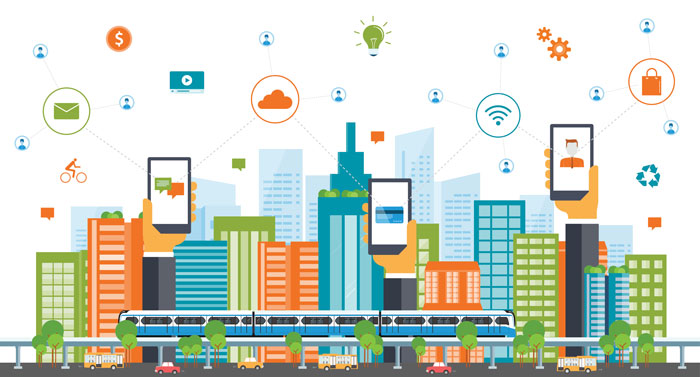Emerging smart cities in Central and Eastern Europe
- Like
- Digg
- Del
- Tumblr
- VKontakte
- Buffer
- Love This
- Odnoklassniki
- Meneame
- Blogger
- Amazon
- Yahoo Mail
- Gmail
- AOL
- Newsvine
- HackerNews
- Evernote
- MySpace
- Mail.ru
- Viadeo
- Line
- Comments
- Yummly
- SMS
- Viber
- Telegram
- Subscribe
- Skype
- Facebook Messenger
- Kakao
- LiveJournal
- Yammer
- Edgar
- Fintel
- Mix
- Instapaper
- Copy Link
Posted: 30 November 2016 | Artur Perchel (Manager – Central Eastern Europe & Israel - UITP) | No comments yet
A plethora of smart city initiatives are already underway across the Central and Eastern Europe (CEE) region. Besides making urban services perform better and more efficiently, a smart city approach can also present great opportunities for investment in public transport and intelligent transportation systems. Here Artur Perchel, Manager – Central Eastern Europe & Israel at UITP, takes a look at how smart cities are emerging in the tech-savvy CEE region, where intelligent mobility and infrastructures are swiftly becoming a new urban paradigm.


Undoubtedly smart cities are on the rise all over Europe and beyond. Optimising and integrating virtually all urban operations and services, smart cities have become a key notion of many urban decision-makers and their respective development agendas. In an era where roughly half of the world’s population lives in cities, intelligent urban solutions help not only to manage daily problems and make cities more competitive, but also to advance the quality of urban life.
Encouraged by scores of success stories in the US, South-East Asia and across Europe, Central and Eastern European cities certainly do not fall short, gradually harnessing smart city and intelligent mobility approaches towards urban policy-making and planning. More often than not though this dynamic is still yet to develop its critical mass throughout the region. Even so, there are numerous case studies of trail-blazing CEE cities that are keeping up with the digital age where smart solutions do make a difference.
The Polish capital’s ‘Virtual Warsaw’ project is an innovative urban information system for the visually impaired and was one of the four awarded runners-up in the 2013-2014 edition of the Mayors Challenge by Bloomberg Philanthropies. This city-wide navigation system is based on thousands of beacons located across the city, including public buildings, mass transit and cultural sites. The transmitters communicate with visually impaired users through mobile apps, such as sending messages to personal handsets or providing dynamic real-time information on bus stops. This highly-intelligent system not only seriously improves peoples’ mobility but also broadens their accessibility and increases users’ self-sufficiency. Furthermore, the project led by the Warsaw Municipality was prized for its relatively balanced budget and strong replication possibilities in other cities…worldwide.
Worth noting is that, besides Warsaw, among 21 shortlisted cities for the 2013-2014 Mayors Challenge there was a good number of other Central and Eastern European municipalities including Brno, Gdansk, Sofia, Stara Zagora and Krakow.


The Polish city of Krakow is implementing a series of intelligent and customer friendly transport system strategies
Despite no final victory in the Mayors Challenge, one of the biggest and certainly most beautiful Polish cities – Krakow – has learnt a lot in terms of intelligent and customer-friendly transport system strategies. As a pioneering CEE city, in October 2015 Krakow inaugurated its first multi-modal bus stop equipped with two big touchscreens and manufactured by a renowned Polish ITS supplier – Novamedia Innovision. While one of the screens displays all kinds of dynamic passenger information and the most recent weather or air quality forecasts, the second one may be used to navigate across a virtual city map in search of useful addresses including cultural sites, hospitals or cafes. Teenagers and PlayStation fans may even click on the ‘game’ icon to enjoy some simple gaming. At the same time, more old school commuters can enjoy on-the-spot music or smile to a CCTV camera that monitors the security in and around the bus stop.
Krakow and Warsaw are not the only cities betting on smart city solutions and intelligent transport systems. As the largest Cohesion country in the region, Poland is eligible to invest up to €18 billion from the European Union’s structural funds for smart city technologies and infrastructure in the 2014-2020 programming period. More than 70% of all Polish local governments have already declared their desire to apply for this money through projects ranging from ITS solutions, efficient water and waste management, to smart energy provision and datadriven urban infrastructures.
One of the more innovative case studies can be found in Gdansk, currently finalising its major ITS project and the biggest intelligent mobility investment in Poland called TRISTAR (Tricity Intelligent Agglomerational Transport System). This €31 million complex urban traffic and public transport fleet management system includes two Traffic Management and Coordination Centres; 160 fully-digitised junctions; and nearly 100 DPI and VMS screens, helping commuters to reduce their travel times by nearly 7%.
Further afield, the local authorities in Vilnius have been trailblazing the Baltic States’ experience with their own smart technologies through the deployment of the Smart Vilnius project. Quite recently, Vilnius was recognised by The New York Times as one of the world’s top 10 best managed municipalities and Smart Vilnius has definitely been part of this highly-acclaimed evaluation. The project’s objective is simple – make the everyday city services and citizens’ experience more accessible and user-friendly, particularly given an impressive smartphone take-up in Lithuania and across CEE. This strategy has resulted in an array of successfully completed projects including e-participation platform; mCity urban transportation apps; an urban smartcard and data-driven traffic management and monitoring systems, to name just a few examples.
Moreover, the entire street lighting system in Vilnius has been replaced by modern energy-saving LED fixtures, contributing to 70% less energy consumed – the equivalent of €2 million of additional savings per year. This and other ongoing initiatives have helped Vilnius to secure the main grant in the 2014 IBM Smarter Cities Challenge, carving a business-friendly image of the Lithuanian capital. Also, in the 2016 Euro barometer survey on the Perception of Quality of Life in Euro pean Cities by the Euro pean Commission, Vilnius scores particularly well, ranking fourth place out of 79 cities.
A smart city concept is also being successfully implemented in the Czech capital under the banner of the Prague SMART City 2014-2020 project. Being among the most advanced cities in Europe, Prague aims to become a true knowledge hub with interconnected measures marrying transport, energy, business, culture, society and infrastructure, all being at the cornerstone of long-term urban innovation and sustainable development.
Prague has one of the highest modal shares for public transport in the whole EU (43%), with relatively cheap and seamless multi-modal and door-to-door mobility services encompassing metro, bus, tram, funicular and waterborne transport. In the aforementioned Eurobarometer survey, Prague found itself comfortably in the list of top 10 cities with the highest citizen satisfaction with public transport.
Recently a bill to set up a local congestion charge zone (Low Emission Zone – LEZ) in the city centre was approved and will come into force on 1 January 2017. While easing commuters’ experience and quality of life, the LEZ regulations will be further strengthened in 2018, allowing only EURO 4 vehicles into the zone. Moreover, there are also some expectations towards the forthcoming Prague Strategy for Adaptation to Climate Change, which should definitely address the means to improving a weak 2%-share of cycling in the city’s modal split.
In terms of infrastructure, new Park & Ride facilities are being built in Prague adding to the 16 that already exist, while smart grid concepts become more and more widespread in waste, water and energy provision. To this end several pilot projects have been established, including SMART Buildings which aim to transform public spaces like schools and social buildings into ecologically sustainable and intelligent buildings with promising energy saving ratios. Moreover, local e-government services are still on the rise, with Prague scoring second in the UN Survey 100 Cities e-Government in 2009. Such initiatives are particularly valuable as they engage citizens’ participation through leveraging technologies and create opportunities for rapid and focused grassroots feedback that city administrations could only dream of just a few years back.


In an industry survey, Prague was comfortably in the top 10 European cities with high public transport passenger satisfaction numbers
Energy-driven smart city endeavours are also common practice in Latvia, where the city of Riga is in the midst of implementing its ambitious ‘Riga City Sustainable Energy Action Plan for Smart Cities 2010 to 2020’ initiative. In a nutshell, the project features a long-awaited transmission to low-carbon and energy efficient urban economy. One of the key investments is in electro mobility and zero-emission vehicles deployment, with more than 50% of local public transport, including trams and trolleybuses, already powered by electricity or – in case of a number of buses – by hydrogen.
In South-Eastern Europe improving quality of life by deploying low carbon economy is at the heart of decision-making in Slovenia’s Ljubljana, currently enjoying the 2016 European Green Capital title – an initiative by the European Commission. Following its smart waste management policy, Ljubljana has already exceeded the EU’s recycling targets for 2020 by 10%. Moreover, the city is the first EU capital to adopt a zero waste strategy and goals, which have already borne fruit as Ljubljana enjoys a 63% share of separated/sorted waste collection: Europe’s highest figure. Also by means of a newly-built and EU-funded regional waste management centre, the city hall aims to reduce the amount of residual waste to barely 60kg per person annually by 2025; what may sound an ambitious target is definitely in their reach.
Moreover, the city has strongly invested in green public transport with 17% of its 221 local bus fleet being CNG buses, plus the deployment of the first public CNG filling station in Slovenia, an investment worth €1.2 million. Likewise, following the ambitious sustainable mobility master plan, the local City Hall has revamped the traffic regime on the main arteries – most notably in and around Slovenskacesta – with priority going to public transport vehicles, cyclists and pedestrians. Each of these measures, including its bike rental scheme Bicike(LJ) or the Urbana City Card, has made the number of public transport passengers increase, particularly since 2012 when it went up by as much as 15%.
Similar examples are endless, showcasing that Central and Eastern Europe is successfully keeping up with the digital age, smartphone-driven data revolution and concepts defining smart cities in other parts of the world. However, as cities continue to grow, so too does urban transport, with traffic congestion often being endemic and costly. Annually the European Union loses over 1% of GDP, or roughly €100 billion, due to traffic congestion. The number of cars worldwide is expected to sky-rocket from 600 million today to nearly 3 billion by 2050, with most of them located in urban areas. That is why smart cities and technologies need a sharp mobility edge, often a car-free or low-carbon one, which will effectively shift traffic patterns and commuter behaviour.
Biography
Artur Perchel is managing all of UITP’s operations and activities in Central Eastern European countries and in Israel. Before joining the organisation at the end of 2012, he gained public affairs and corporate experience from London-based research consultancy ComRes and Brussels-based trade association AmCham Belgium. Earlier, Artur worked as a PhD Researcher at Ghent University.
Issue
Issue 6 2016
Related cities
Czech Republic, Latvia, Poland
Related organisations
International Association for Public Transport (UITP)
Related people
Artur Perchel



